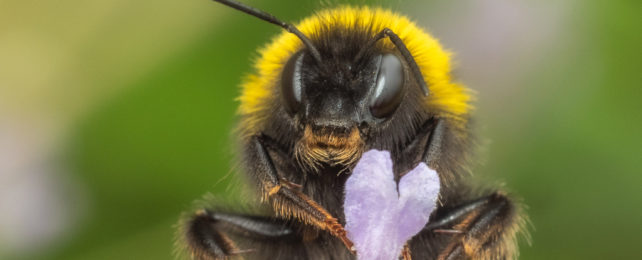 Bumblebee holding a flower. (Frank Wolf/500px/Getty Images)
Bumblebee holding a flower. (Frank Wolf/500px/Getty Images)Evidence is mounting that insects experience pain in a similar way that we do. Now, a clear demonstration of play in bumble bees suggests pleasure may be part of the lived experience of these tiny animals too.
"It goes to show, once more, that despite their little size and tiny brains, they are more than small robotic beings," says behavioral ecologist Samadi Galpayage from the Queen Mary University of London (QMUL).
Galpayage and colleagues created a playground of sorts for 45 buff-tailed bumble bees (Bombus terrestris).
The set-up provided them with the option of walking directly to a food foraging area through a clear path or choosing to be diverted by an obstacle course of little wooden balls on either side of the thoroughfare instead.
On one side those balls were fixed in place, but on the other side they were loose.
The curious little animals did not disappoint – each investigated the balls, giving ball-rolling a shot at least once. Every individual bee rolled the balls up to 117 times across the whole experiment period, showing no preference between the different colors.
Most bees continued to roll balls for another day or two once they'd finished feeding in the foraging area.
"It is certainly mind-blowing, at times amusing, to watch bumble bees show something like play," says Galpayage, who is also the study's first author.
Before each bee rolled their first ball, they showed an equal preference for each path. Once the rolling began, most bees repetitively chose to enter the mobile object area.
"They approach and manipulate these 'toys' again and again," Galpayage explains. "They may actually experience some kind of positive emotional states, even if rudimentary, like other larger fluffy, or not so fluffy, animals do."
Pleasure is what reinforces our own play behavior, after all, strongly compelling us and other animals to continue and refine our cognitive and motor skills in the process.
In this case, ball-rolling may help these winged balls of floof learn to handle flowers more deftly while extracting nectar – an activity bees improve on with experience.
What's more, the new research found juvenile bees rolled more balls – the same sort of pattern we see in mammals, with youngsters (those most in need of practice), being more inclined to play.
Galpayage and team then trained another 42 bumblebees to associate ball rolling with a colored chamber and later provided them with the option of two different colored empty chambers. The bees were unable to see what was within the chamber, yet more bees still chose the color they'd linked with the balls.
In this experiment, the ball rolling preference was not associated with an area that accessed food. Nor was it linked to clearing clutter or mating – demonstrating the preference was for the act of play in itself.
The bumblebee's ball-rolling met all five criteria for the phenomenon of play: an activity that isn't immediately functional; is voluntary, spontaneous, and inherently rewarding; differs from other adaptive behaviors; is repeated but also changes (as opposed to bored animals rocking or pacing over and over in a zoo); and only occurs in the absence of stress.
"We suggest that the behavior observed here has actual hedonic value for bumble bees, which adds to the growing body of evidence of a form of sentience in these insects," the researchers conclude.
While insects have long been dismissed as mindless entities with automatic responses to the world, a closer look has revealed that despite their tininess they're still packed with many of our fundamental, yet complex behaviors. From communicating through dance and impressive levels of cooperation, to counting these tiny animals are capable of far more than we've ever really given them credit for.
"This research provides a strong indication that insect minds are far more sophisticated than we might imagine," explains QMUL behavioral ecologist Lars Chittka. "We are producing ever-increasing amounts of evidence backing up the need to do all we can to protect insects that are a million miles from the mindless, unfeeling creatures they are traditionally believed to be."
The prospect of insects having feelings from pain to pleasure raises ethical questions, like those recently considered for cephalopods and crustaceans, especially in light of troubling insect declines and proposed mass farming of insects in the future.
"This sort of finding has implications to our understanding of sentience and welfare of insects and will, hopefully, encourage us to respect and protect life on Earth ever more," concludes Galpayage.
This research was published in Animal Behavior.





No comments:
Post a Comment